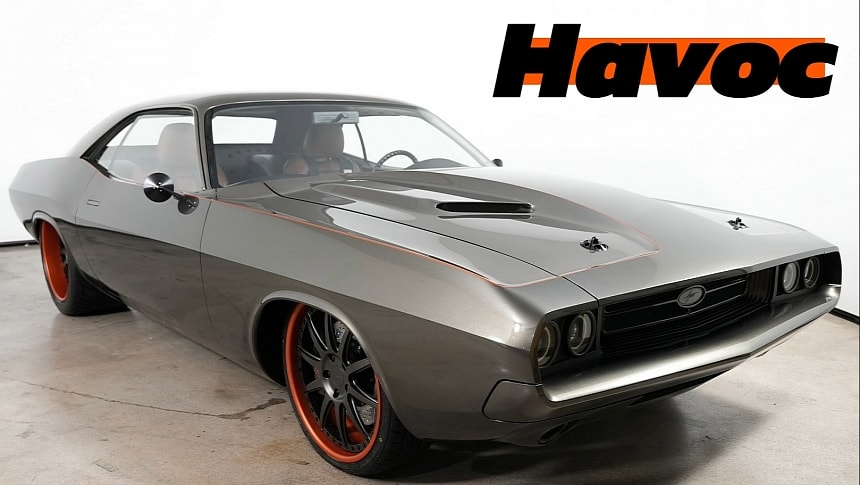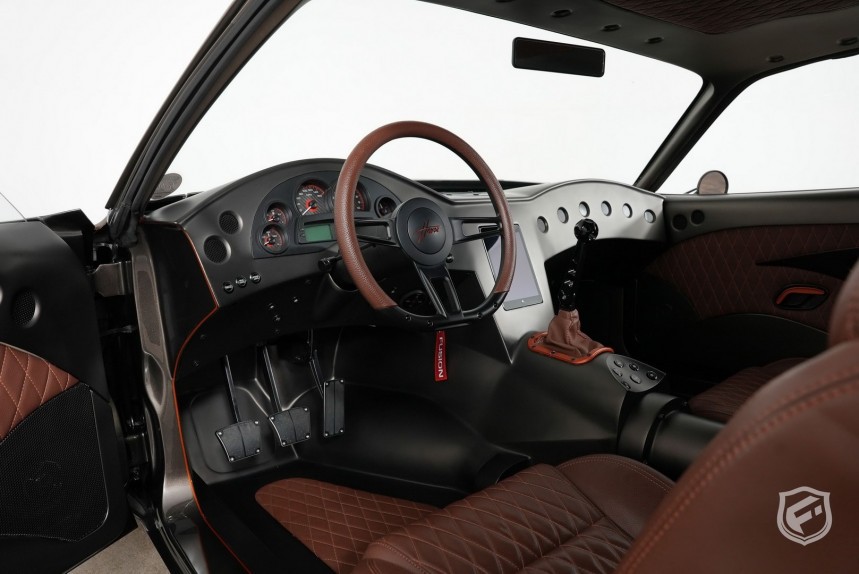When it comes to custom classic Challengers, there’s no shortage of exceptional builds out there. Yet, despite all the king’s horses and all the king’s men, few (if any) of them can actually hold a candle to this heavily customized 1970 model year Dodge with its incredible 2,500 HP.
This thing might be more insane than that one-off Charger featured in the Fast & Furious franchise, the one that Vin Diesel drove. It was called ‘Maximus’ and it featured a twin turbocharged 9.4-liter Hemi V8, good for 2,250 horsepower. It’s been dubbed the “ultimate Charger”, and in that spirit, we’d like to dub this, the “ultimate Challenger.”
Also, have you heard the news about Hennessey building a 1,700-horsepower twin turbo Demon 170? Child’s play. This here Challenger, dubbed ‘Havoc’, can reportedly produce up to 2,500 horsepower thanks to its Stanton Race Engine (by itself good for 900 HP) and its F3R ProCharger supercharger.
Everything you see on this car is custom. Even the front end, so that it could hold the new 572 ci (9.4-liter) Hemi engine – itself featuring race-spec valves and cylinder heads, a 4.7-inch throttle body, 2,200 cc injectors, the supercharger, upgraded bores, and more.
Meanwhile, other highlights include the custom ‘Havoc’ badging, a set of American Legend Blackhawk wheels with Mickey Thompson tires, airbag suspension, a custom Tremec Magnum T56 six-speed manual gearbox with a Roadster Shop 9-inch differential, and NASCAR power rack-and-pinion steering. As for the interior, that’s where you’ll find the VF Commodore seats, Billet Specialties steering wheel, Dakota Digital instrumentation, Ringbrothers shifter, or the custom sound system.
The idea behind this car was to create something completely unique without using off-the-shelf aftermarket upgrades. This explains why it took a full three years and 10,000 hours to build - most of the body panels were built from scratch. By the way, work on the car was completed back in 2019, and in 2022, Havoc was de-tuned from 101 octane to 91 pump fuel so that it could be more practical as a daily driver.
It essentially went from 2,500 horsepower to 1,200 horsepower, but that’s a fixable “problem” should its future owner demand maximum performance at all times.
Speaking of future owners, the car is currently for sale, but you’ll have to contact Fusion Motor Company in order to find out the price. They probably didn’t want a fixed sum of money floating around out there, which is why they didn’t list the car with a price tag.
Also, have you heard the news about Hennessey building a 1,700-horsepower twin turbo Demon 170? Child’s play. This here Challenger, dubbed ‘Havoc’, can reportedly produce up to 2,500 horsepower thanks to its Stanton Race Engine (by itself good for 900 HP) and its F3R ProCharger supercharger.
Everything you see on this car is custom. Even the front end, so that it could hold the new 572 ci (9.4-liter) Hemi engine – itself featuring race-spec valves and cylinder heads, a 4.7-inch throttle body, 2,200 cc injectors, the supercharger, upgraded bores, and more.
Meanwhile, other highlights include the custom ‘Havoc’ badging, a set of American Legend Blackhawk wheels with Mickey Thompson tires, airbag suspension, a custom Tremec Magnum T56 six-speed manual gearbox with a Roadster Shop 9-inch differential, and NASCAR power rack-and-pinion steering. As for the interior, that’s where you’ll find the VF Commodore seats, Billet Specialties steering wheel, Dakota Digital instrumentation, Ringbrothers shifter, or the custom sound system.
The idea behind this car was to create something completely unique without using off-the-shelf aftermarket upgrades. This explains why it took a full three years and 10,000 hours to build - most of the body panels were built from scratch. By the way, work on the car was completed back in 2019, and in 2022, Havoc was de-tuned from 101 octane to 91 pump fuel so that it could be more practical as a daily driver.
Speaking of future owners, the car is currently for sale, but you’ll have to contact Fusion Motor Company in order to find out the price. They probably didn’t want a fixed sum of money floating around out there, which is why they didn’t list the car with a price tag.

























